What is Tonjiru (Butajiru)?
Tonjiru (豚汁) is a type of miso soup made with pork and vegetables. Root vegetables are often used to make the dish nutritious and filling, and miso paste is predominately used for seasoning and flavor. The name is made up of the characters 豚 which means “pork” and 汁 which means “soup.” In some regions, this dish is also known as “butajiru” but I’ll explain more later.
On a side note, if you use chicken instead of pork, it will be called Torijiru (Chicken Miso Soup).
Tonjiru is a favorite dish in many Japanese homes. What makes it so loved? It’s all about the broth, which pulls in the flavors of all the ingredients. The unique taste and texture of soft pork belly set it apart from other meats like chicken or beef and give the soup a special flavor.
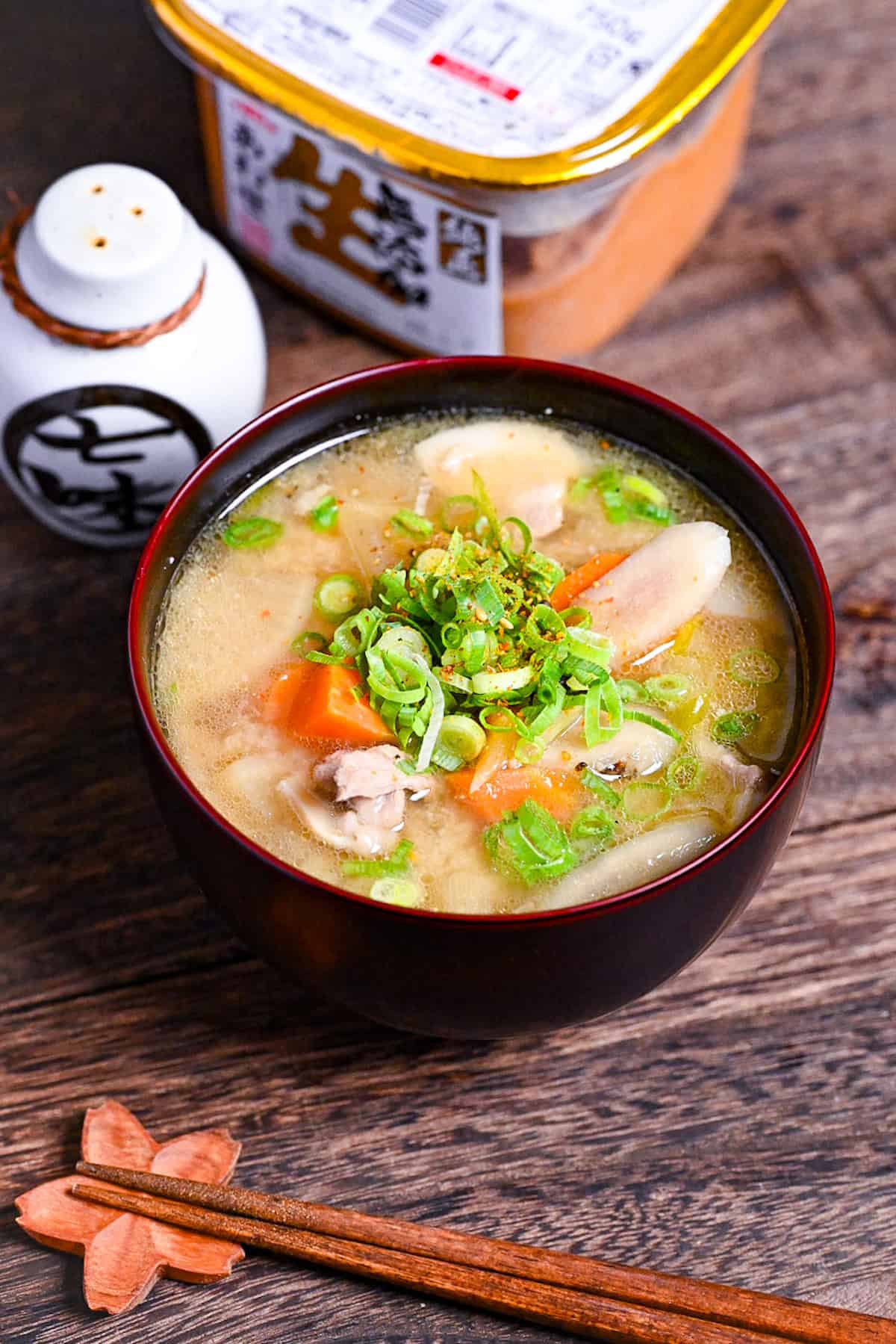

How I Developed This Recipe
When I first tried making this tonjiru recipe, I wanted to put my own spin on this well-loved dish.
To get this result, I used butter, which is a bit of an unusual choice but gives the dish a rich, creamy twist. Instead of the usual thin pork slices, I went for thicker cuts.
If you’re looking to try something new with your miso soup, I highly recommend this hearty tonjiru version.
Key Elements of Tonjiru
The key elements in Tonjiru are dashi broth, miso paste, pork, and vegetables. Let’s look at each element in detail.
Dashi Broth
At the heart of a flavorful Tonjiru is its dashi base. Dashi broth, a vital Japanese stock, can be made from a few different core ingredients. Some of these include:
- Kombu dashi: Made from dried kelp.
- Katsuobushi dashi: Created using bonito flakes from skipjack tuna.
- Shiitake Dashi: Uses dried shiitake mushrooms.
In this recipe, we’ll be cooking up Tonjiru using homemade dashi, lovingly brewed with a blend of kombu and katsuobushi. This type of dashi is called “awase dashi,” and we’ve got a detailed recipe ready for you to follow.
For those who seeking a quicker route, dashi granules or dashi packets (similar to teabags) can be easily found on Amazon. These can be your shortcut to a comforting bowl of Tonjiru.
Miso Paste
Japan’s miso landscape is as diverse as it is delightful, with the type of miso you choose for your miso soup ultimately boiling down to personal preference. Here’s a quick rundown of the different types of miso you might encounter in Japan:
- Rice Miso (米味噌): A trio of rice, soybeans, and salt makes up this common variant.
- Barley Miso (麦味噌): Crafted from wheat, soybeans, and salt, it’s a frequent find in the Chugoku, Shikoku, and Kyushu regions.
- Soybean Miso (豆味噌): Made with just soybeans and salt, this type is particularly popular in the Chukyo region (which happens to be my home turf!).
- Mixed Miso (調合味噌): This type is a tasty blend of two or three types of rice miso, barley miso, or soybean miso.

Miso can also be grouped by color, each offering a distinct flavor profile:
- White Miso (白味噌): Known for its light, delicate taste.
- Red Miso (赤味噌): Offers a deeper, richer taste.
- Mixed Miso (合わせ味噌): A perfect balance in taste.
These are just the broad strokes, though. The miso universe in Japan is vast, with countless variations from region to region. Traditionally, families even made their own miso at home, leading to differences from one household to the next.
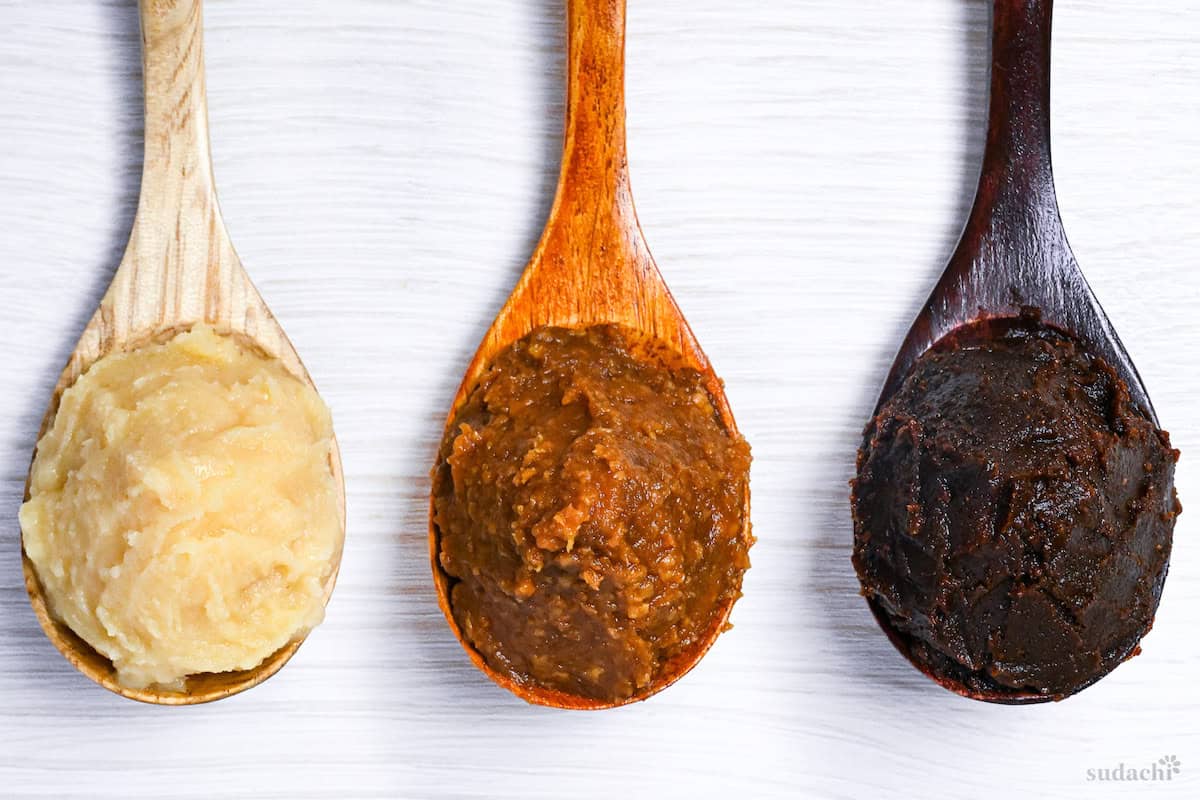
A fun fact about my hometown, Okazaki, is that it’s famous for producing Hacho Miso, a kind of deep, rich red miso paste.
In my recipe, I opted for “awase miso” (yellow) this time. The choice of miso, much like any ingredient, can greatly change the character of your Tonjiru, making each bowl a unique experience.
If you’re interested in recommended brands, check out my miso paste 101 post.
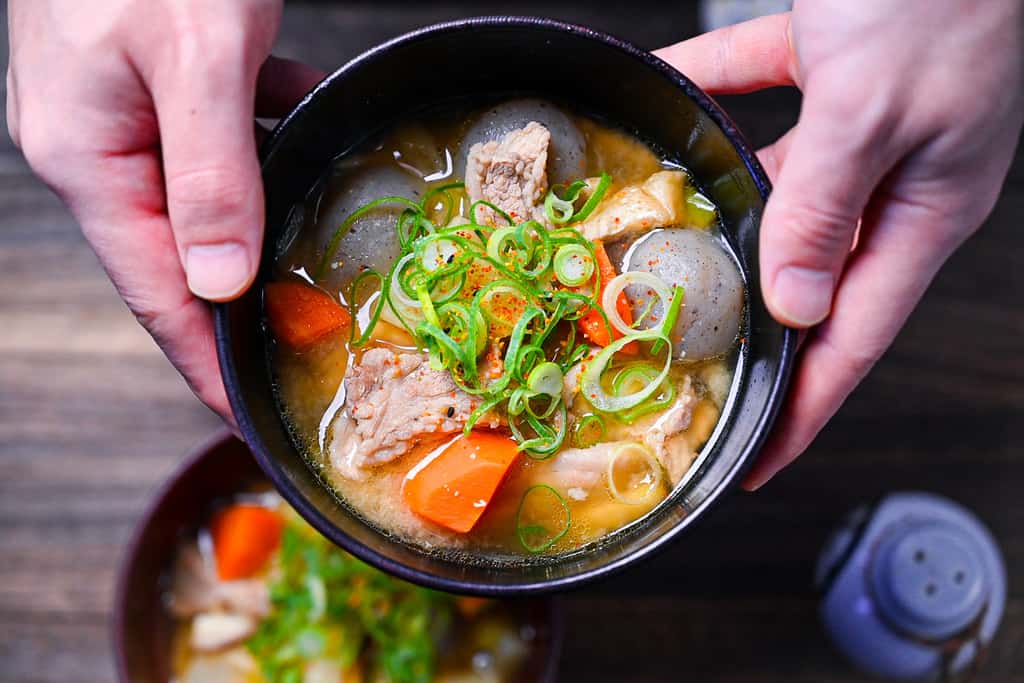
Other ingredients
Tonjiru, unlike its ordinary miso soup counterpart, boasts a medley of ingredients that inject it with its distinctive character. It’s like a festive gathering of flavors, each adding its unique touch. Here are some of typical ingredients used:
- Carrots: These bring a touch of sweetness.
- Green Onion: For that vibrant green and mild zing.
- Potatoes: Often, “satoimo” or taro is used, imparting a delightful creaminess.
- Mushrooms: Japanese varieties like shiitake, enoki, eryngii, and shimeji are popular choices.
- Daikon Radish: This adds a refreshing crunch.
- Burdock root: Also known as “gobo” in Japanese is a common pick that adds a unique flavor.
- Tofu: For a silky, satisfying bite.
- Konjac (konnyaku): This adds a unique texture to the mix.
While the choice of ingredients ultimately rests with you, I’d suggest picking at least three from this list to ensure a symphony of flavors in your bowl of tonjiru.
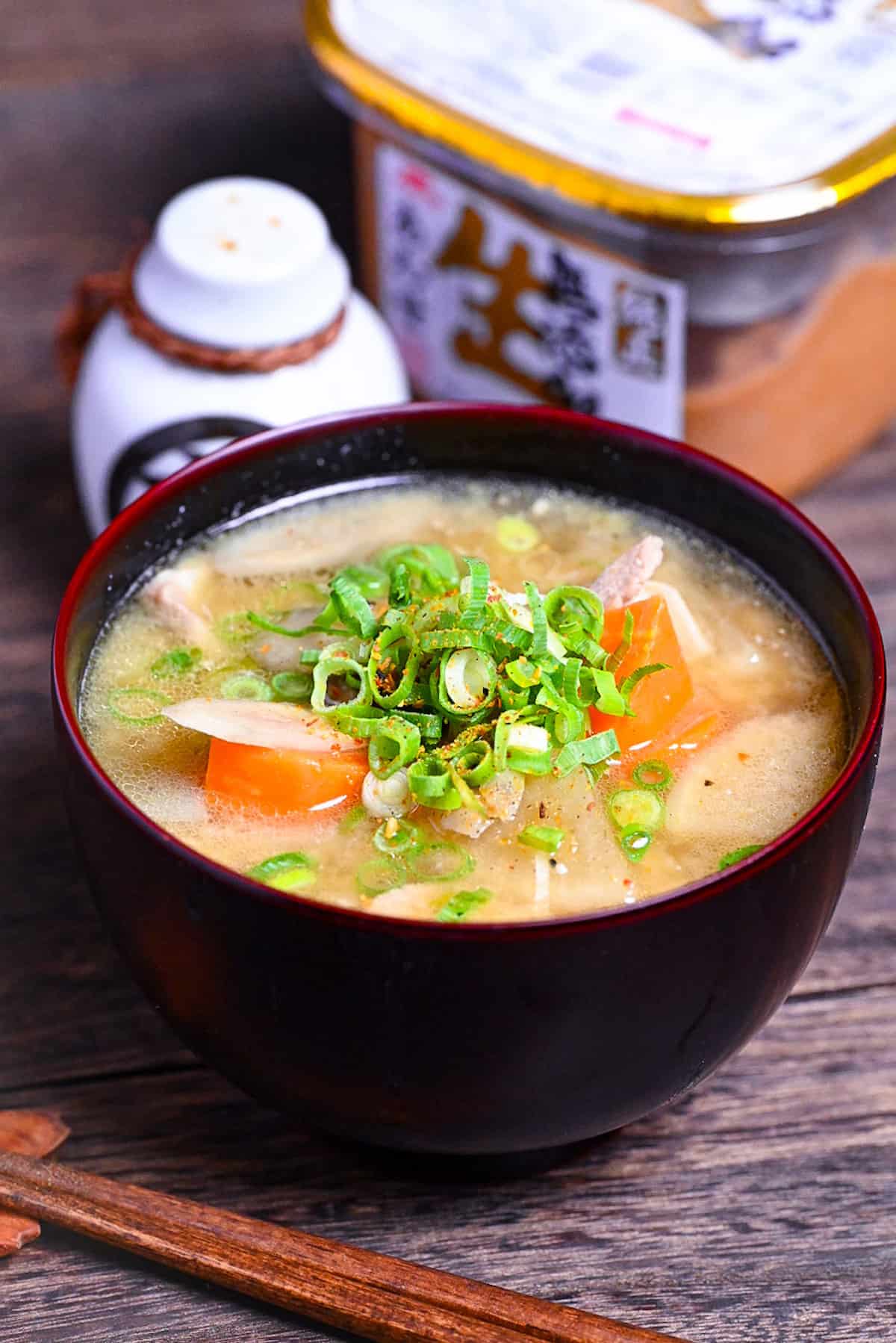
Visual Walkthrough & Tips
Here are my step-by-step instructions for how to make delicious Tonjiru at home. For ingredient quantities and simplified instructions, scroll down for the Printable Recipe Card below.
If you prefer to watch the process in action, check out my YouTube video of this recipe for a complete visual walkthrough!
Cut the pork belly into slices about 2mm thick. I recommend using a sharp knife and cutting it straight from the fridge so that it’s firm and holds its shape.
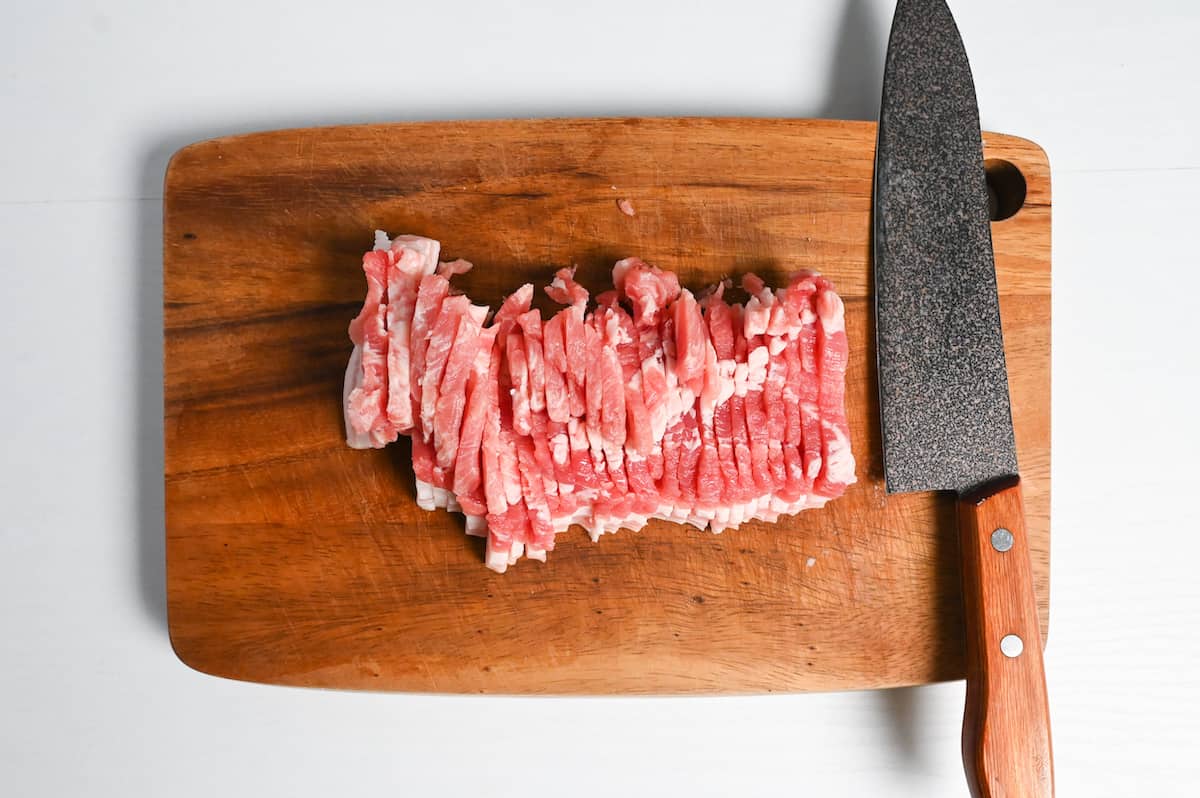
It’s actually more common in Japan to use the thinly sliced pork belly you can buy from the store, but I personally find it’s so thin that it becomes lost in the soup. Using a pork belly block is not only more accessible but also adds more texture and a meaty feeling to the soup. But of course, this depends on preference. Feel free to use thinly sliced if you prefer!
Wash and scrape the skin off the burdock root, then cut it diagonally into thin slices. Thinly slice the fried tofu pouch, green onion, and shiitake mushrooms. Peel and cut the carrot and daikon radish into bitesize chunks. If using konjac, cut it into bite-sized chunks, blanch it in hot water, and rinse it with cold water to remove the odor.
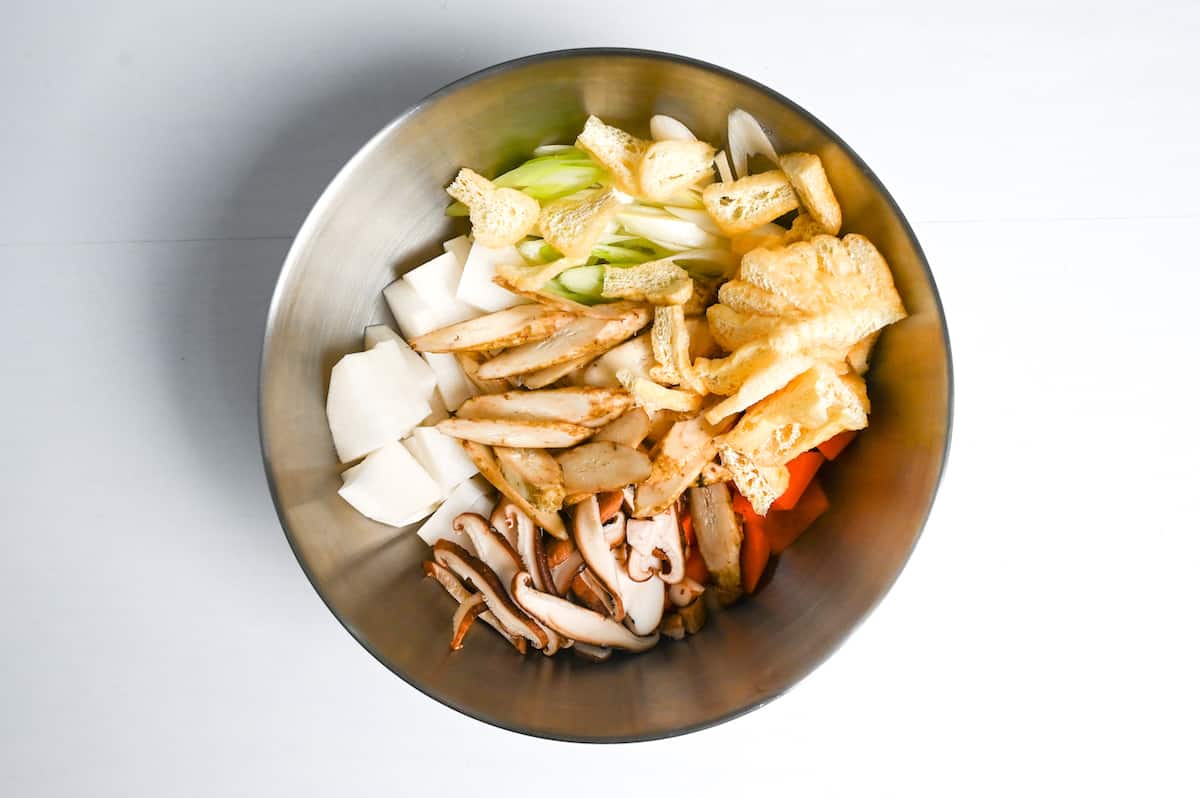
Use a good variety of vegetables (and tofu) to make tonjiru. By adding more vegetables, the delicious and complex essence from them will come out and make the dish have more depth of flavor. It also makes it more comforting and nutritious!
Heat a large pot on a medium heat and melt unsalted butter. Add the pork and seal on both sides. Using butter rather than oil adds a richer flavor and compliments the pork and miso!
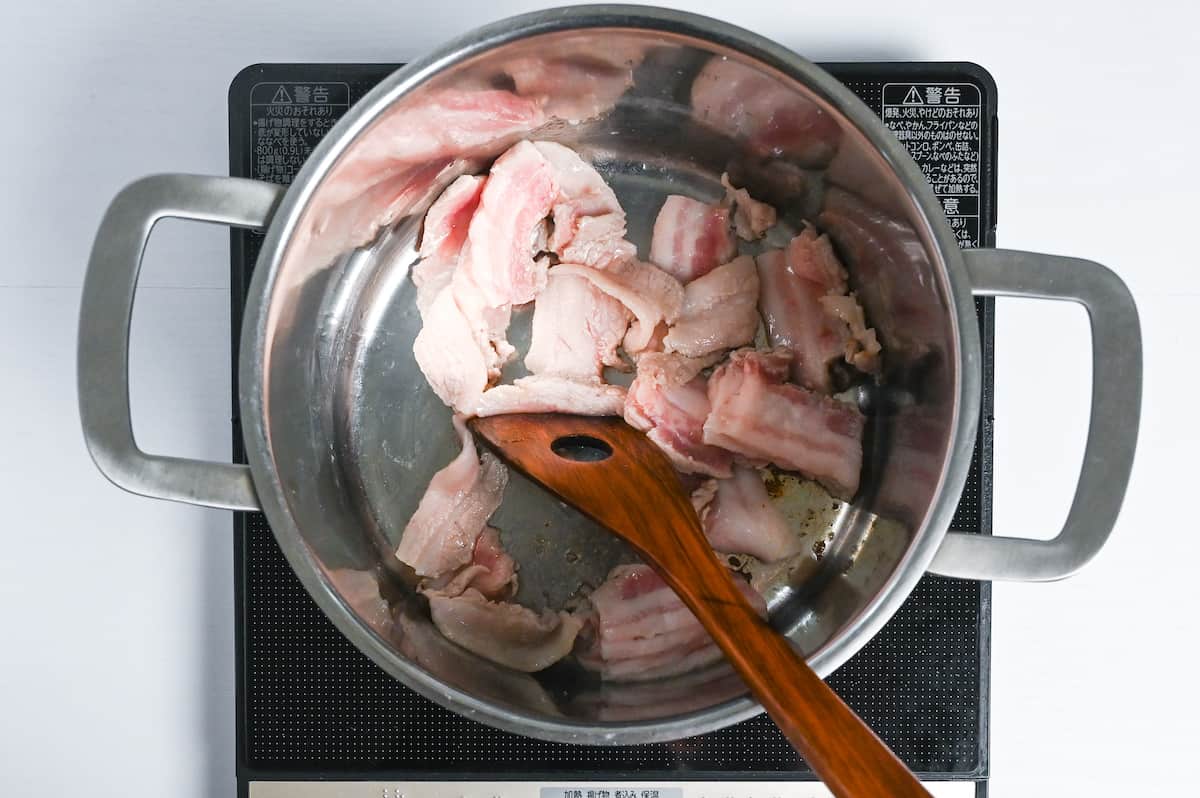
Next, add the sliced burdock root and stir fry for one minute.
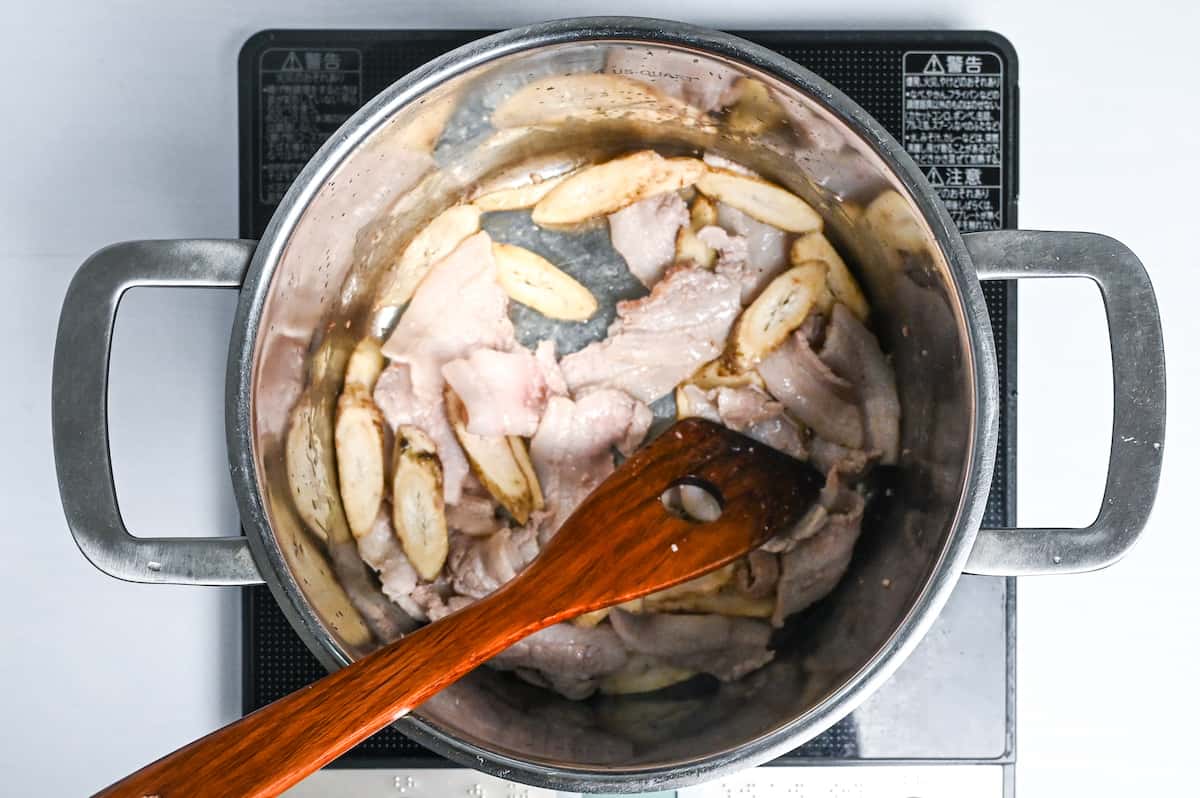
Then, add the carrot, daikon radish, shiitake mushrooms, konjac and fried tofu pouch. (Don’t add the green onion yet.)
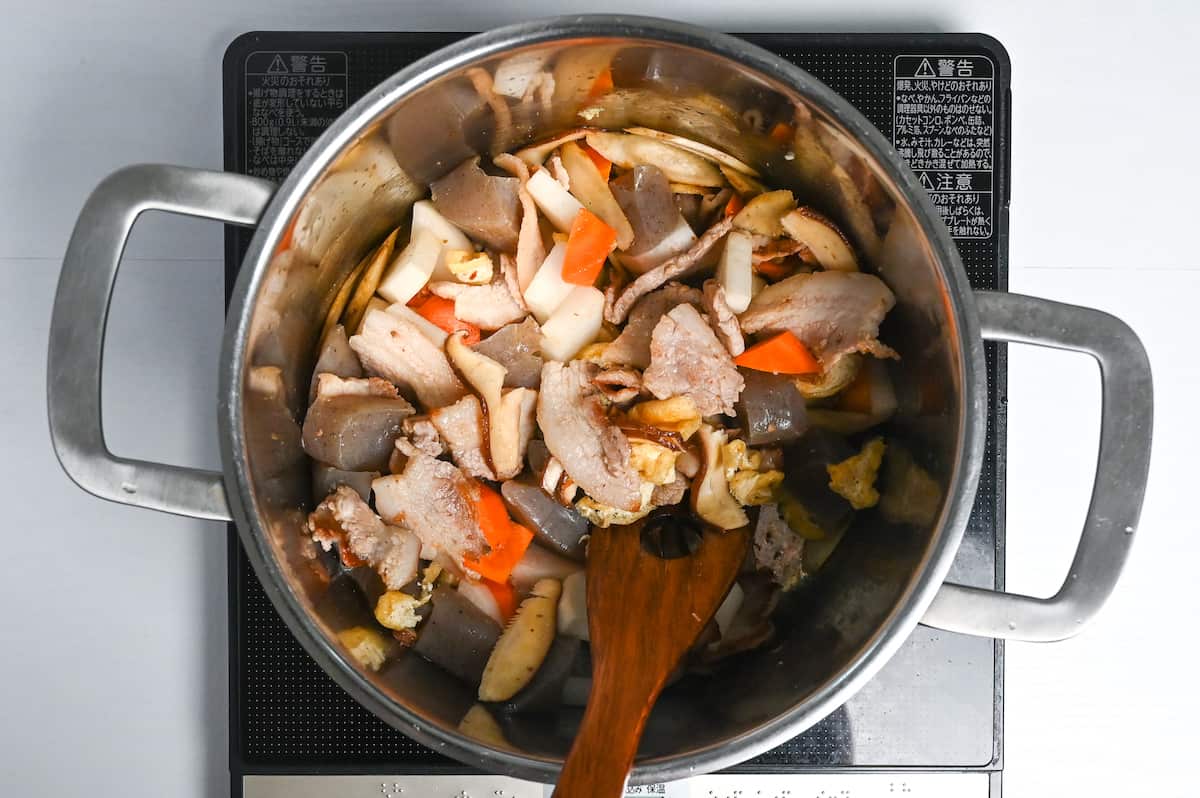
Mix the contents of the pot thoroughly and add the dashi.
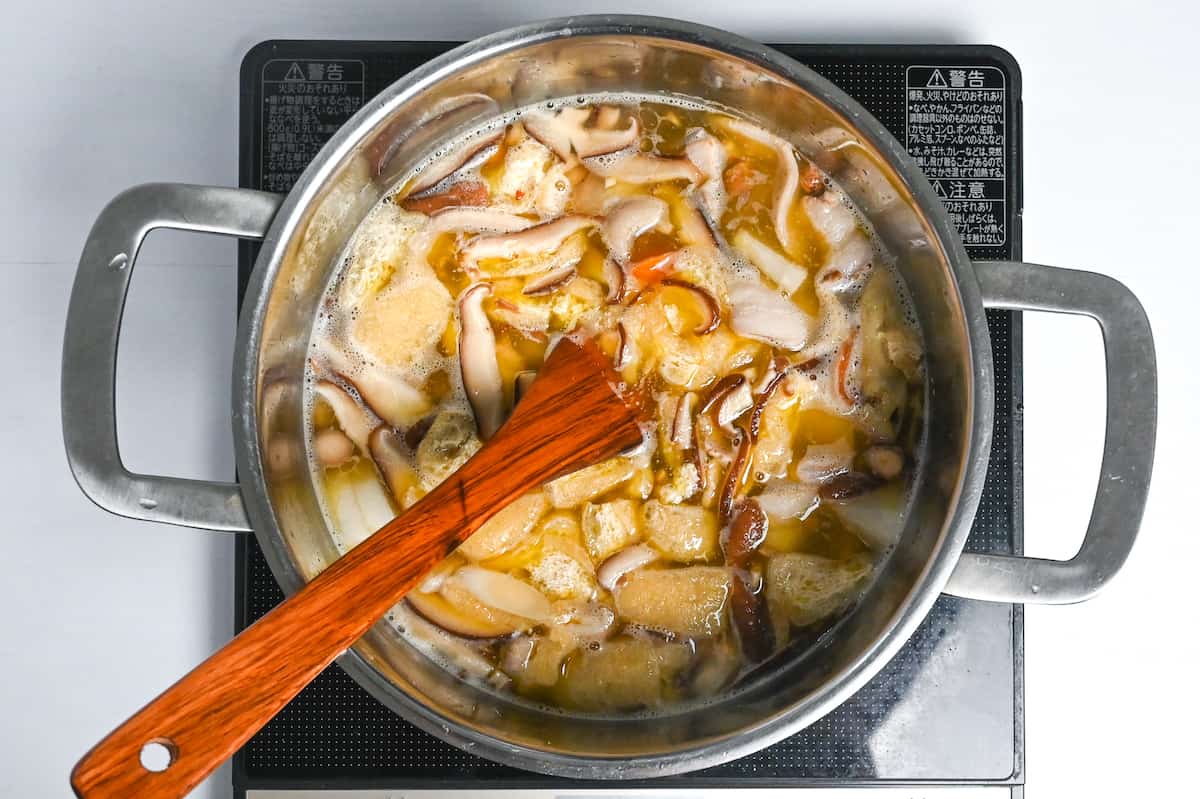
Add the first half of the miso paste by placing it in a mesh spoon, submerging it in the broth and mixing thoroughly until it’s incorporated. This technique prevents lumps of miso and ensures it’s evenly distributed throughout the soup. Mix well and simmer for 15 minutes.
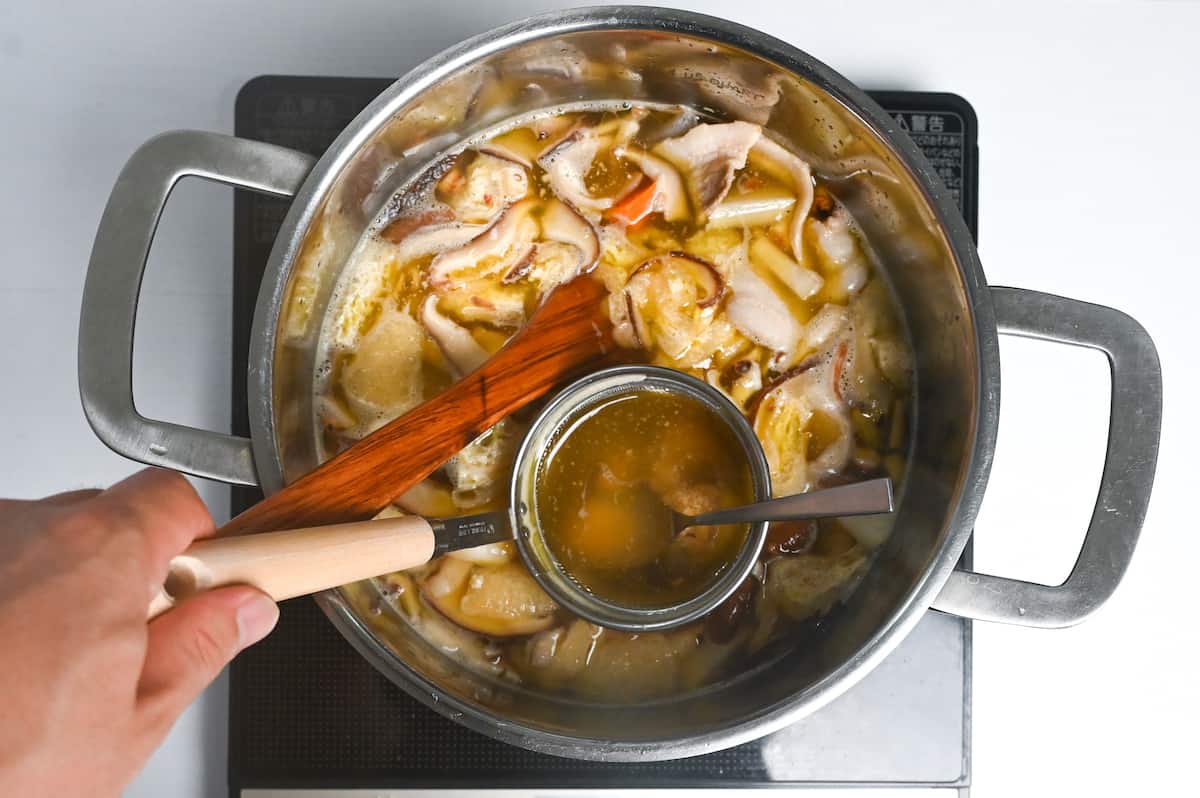
The purpose of the miso here is to allow the flavor to be absorbed into the vegetables. Miso tends to lose flavor the longer it’s heated, so we flavor the soup right at the end to ensure maximum flavor.
As the soup simmers, the pork will release scum that floats to the surface. Scoop it off as it appears using a mesh spoon.
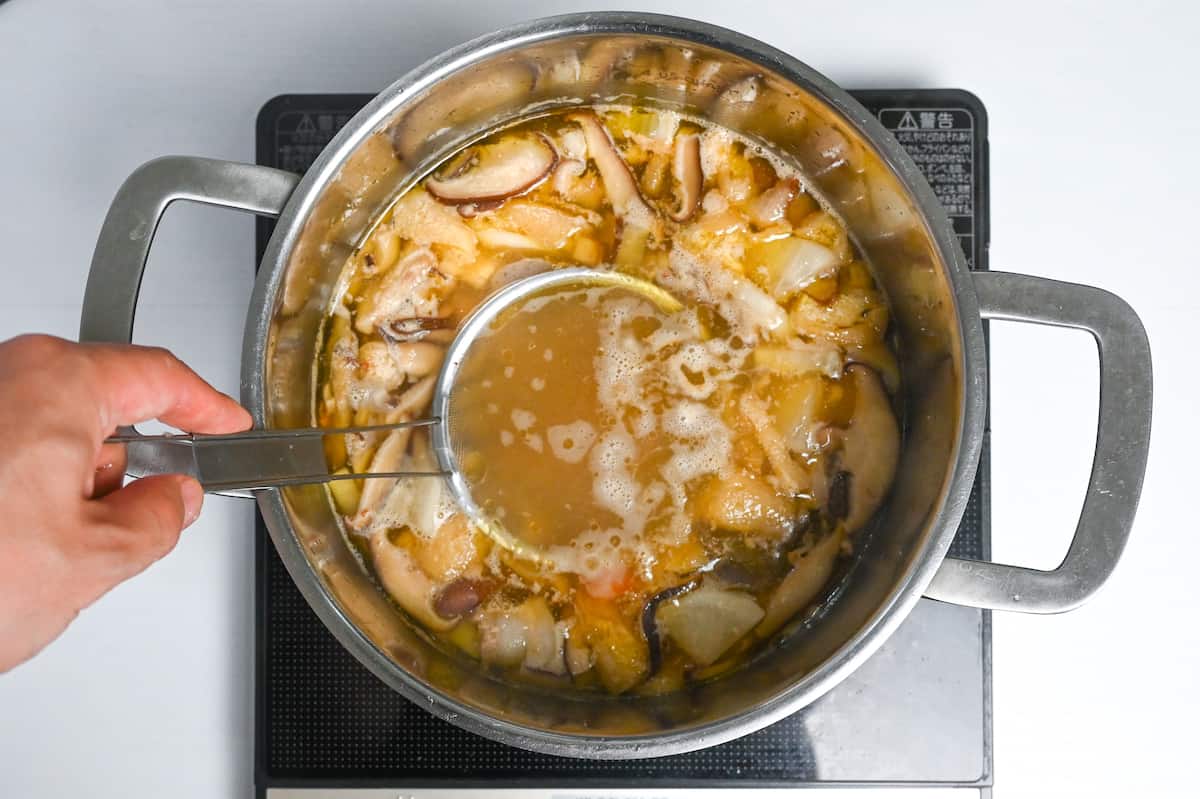
After 15 minutes, add the green onion and simmer for another 10 minutes.
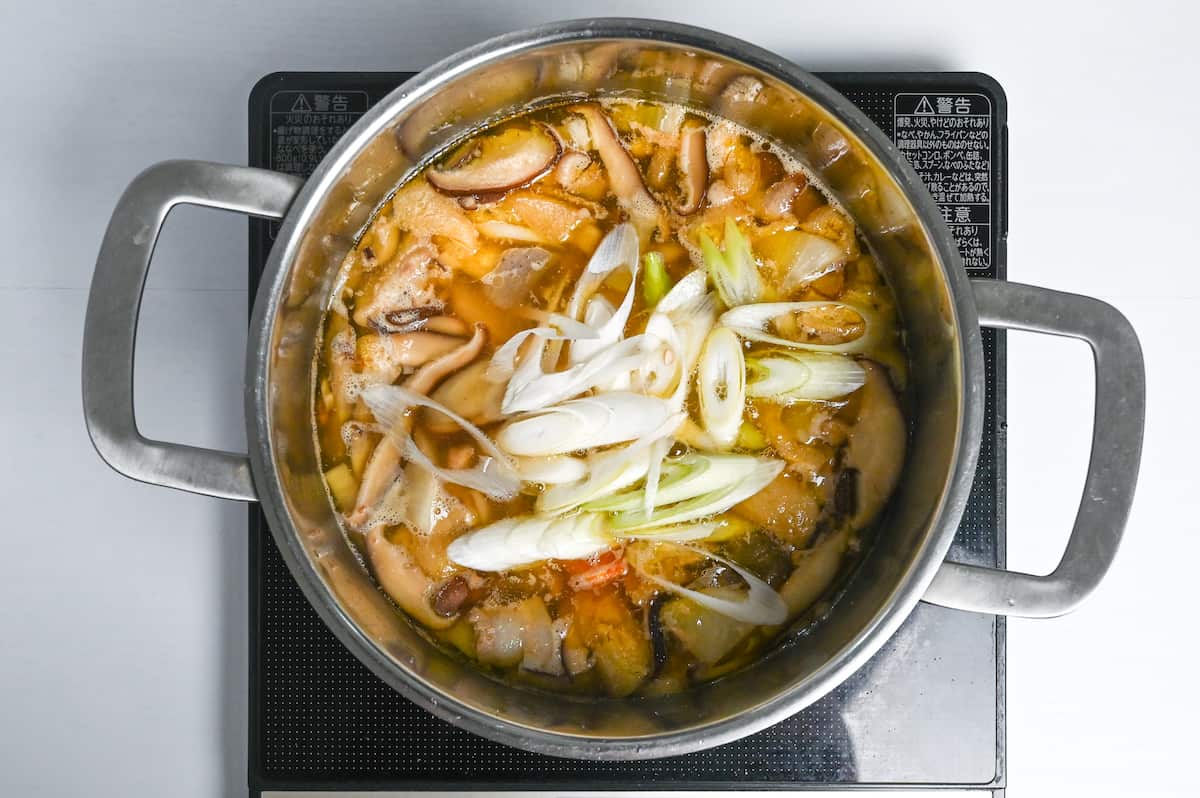
Add the soy sauce and mirin, then turn off the heat. Using the mesh spoon technique from before, add the other half of the miso paste. Taste test and add more miso if needed.
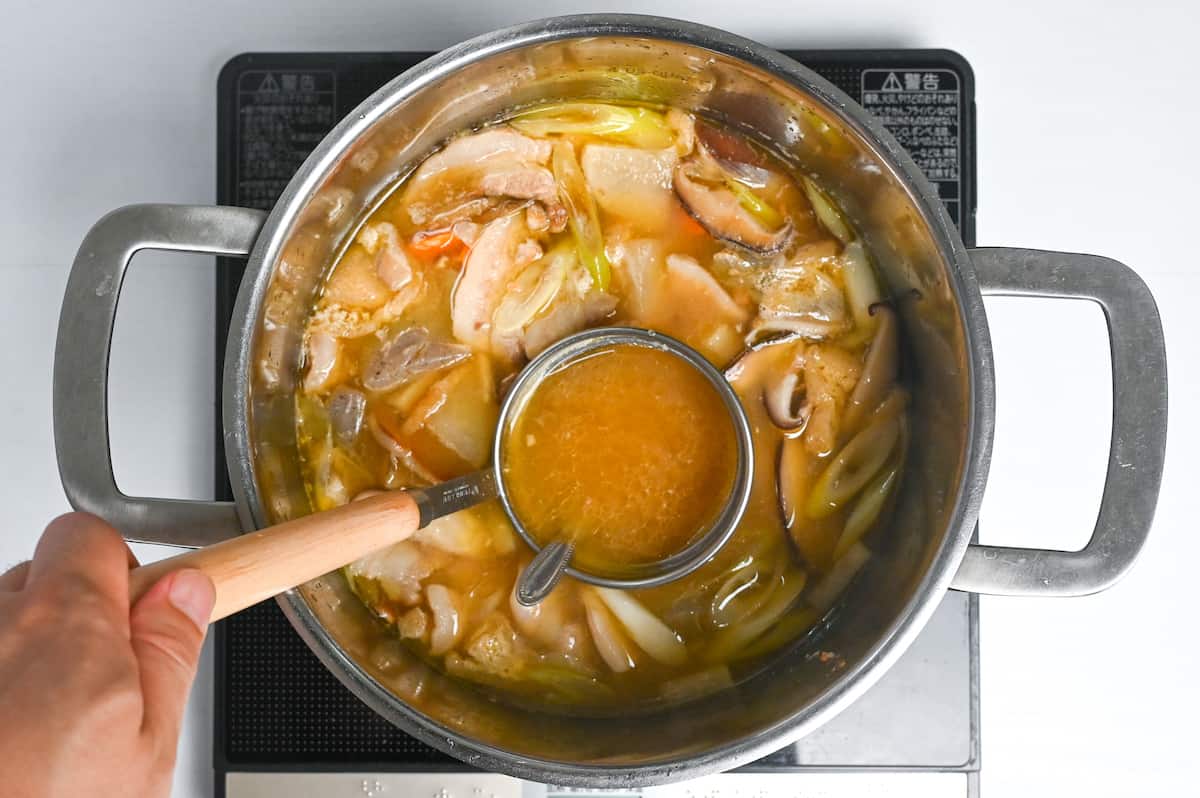
Divide the soup into serving bowls, drizzle with sesame oil, and top with chopped green onion.
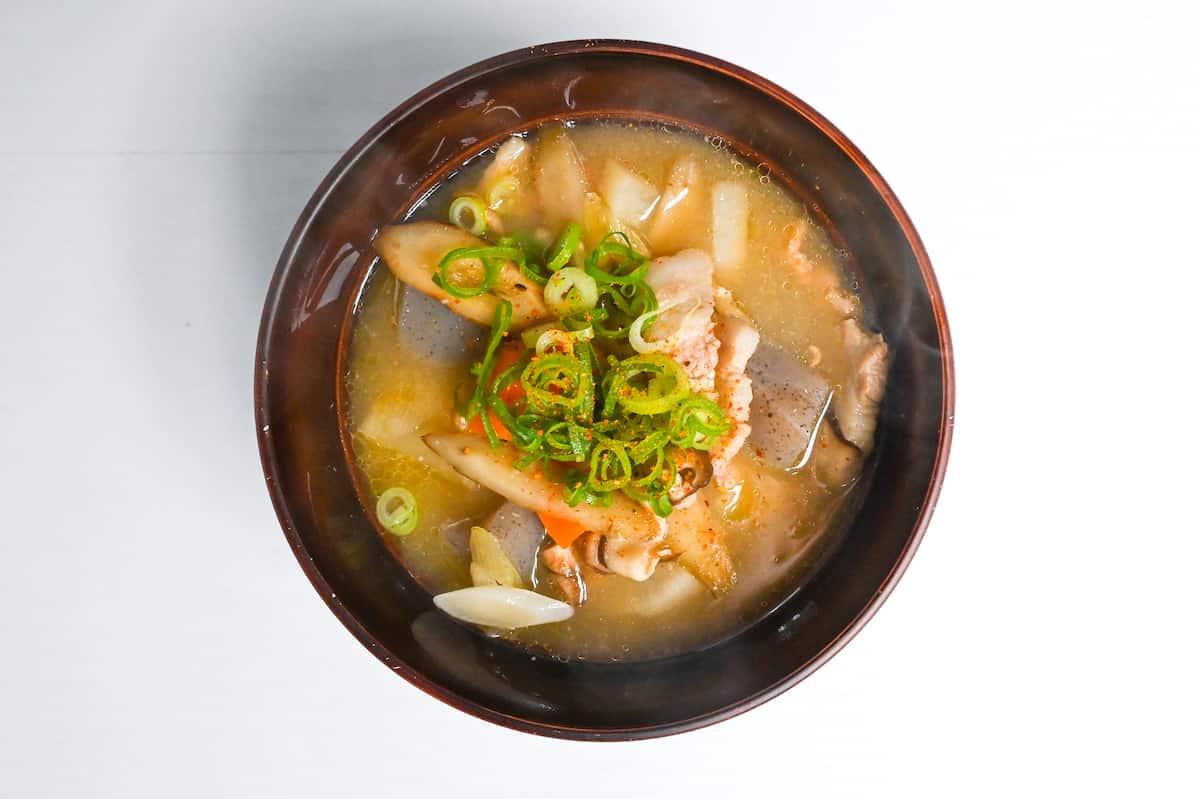
Enjoy!
Jump to Full Recipe MeasurementsI hope you enjoy this Tonjiru recipe! If you try it out, I’d really appreciate it if you could spare a moment to let me know what you thought by giving a review and star rating in the comments below. It’s also helpful to share any adjustments you made to the recipe with our other readers. Thank you!
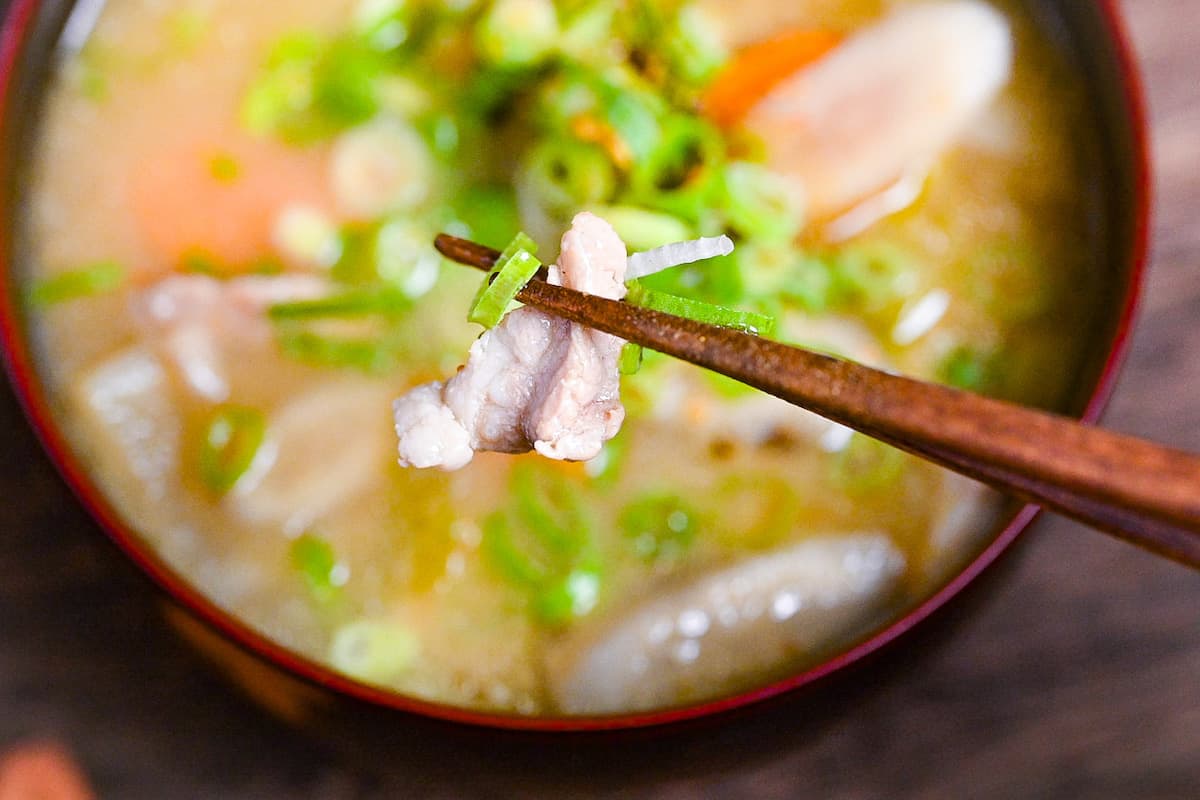
More Miso Soup Recipes
Hungry for more? Explore my miso soup recipe collection to find your next favorite dishes!
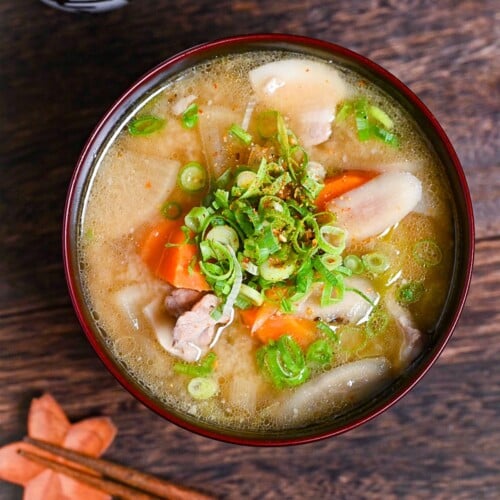
Tonjiru (Butajiru) Japanese Pork Miso Soup
Ingredients
- 200 g slab skinless pork belly chilled
- 350 g daikon radish peeled, thickly sliced and quartered
- 150 g carrot roughly cut into bitesize pieces
- 75 g burdock root (gobo) peeled and thinly sliced diagonally
- 20 g fresh shiitake mushroom stems removed and thinly sliced
- 50 g Japanese leek (naganegi) thinly sliced diagonally
- 400 g konjac (konnyaku) cut into bitesize pieces
- 60 g fried tofu pouch (aburaage) thinly sliced
- ½ tbsp butter
- 1500 ml dashi stock see how to make homemade dashi here
- 6-7 tbsp yellow miso paste (awase)
- 1 tsp Japanese soy sauce (koikuchi shoyu)
- 1 tsp mirin
- toasted sesame oil to garnish
- finely chopped green onions optional
- Japanese chili powder (shichimi togarashi) optional
My recommended brands of ingredients and seasonings can be found in my Japanese pantry guide.
Can’t find certain Japanese ingredients? See my substitution guide here.
Instructions
Prep
- Cut the 200 g slab skinless pork belly into slices 2mm thick. (I recommend doing this straight from the fridge.)

- Wash, peel and cut 350 g daikon radish, 150 g carrot, 75 g burdock root (gobo), 20 g fresh shiitake mushroom, 50 g Japanese leek (naganegi) and 60 g fried tofu pouch (aburaage) according to the notes in the ingredients list.

- Use a spoon to break 400 g konjac (konnyaku) into bitesize pieces. Blanch and wash with cold water.

Cooking
- Heat a large pot on medium and once hot, add ½ tbsp butter. Add the pork belly slices and seal on both sides.

- Add the burdock root to the pot and stir fry for 1 minute.

- Next, add the carrot, daikon radish, mushroom, konjac and aburaage, and mix everything together.

- Pour 1500 ml dashi stock into the pot and stir.

- Measure out 6-7 tbsp yellow miso paste (awase) and add half of it to the soup by placing it in a mesh spoon or ladle, submerging it into the broth and whisking on the spoon to break it up. Mix and simmer for 15 minutes.

- Scoop off any foam that develops on the surface of the soup. (This will prevent the broth from becoming cloudy.)

- Add the sliced green onion and simmer for another 10 minutes.

- Add 1 tsp Japanese soy sauce (koikuchi shoyu) and 1 tsp mirin, then turn off the heat. Add the rest of the miso paste using the same technique as before. Taste test and add more miso paste if needed.

- Divide into serving bowls and top with a drizzle with toasted sesame oil, finely chopped green onions and a sprinkle of Japanese chili powder (shichimi togarashi) (optional).

- Enjoy!
Video
Notes
- Choose between pork options: use pork belly block for meatier texture, or traditional thin-sliced pork belly for lighter taste.
- Add a variety of vegetables and tofu to develop complex, deep flavors in the soup.
- Add miso in two stages: first round to flavor vegetables, final round just before serving to maximize taste.
- If you have leftovers, you can store them in the fridge and eat them within 2-4 days, depending on season and climate (see in post for more details).
- Do not freeze tonjiru.
- When reheating, heat on the stove and turn off the heat just before it starts to boil. (Overcooking will diminish the flavor of the miso paste.)
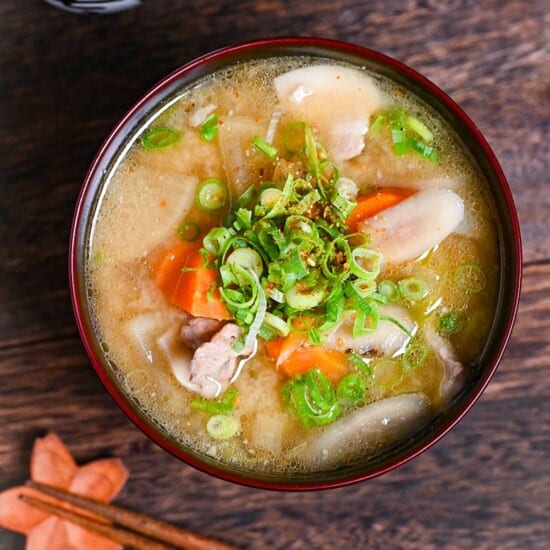





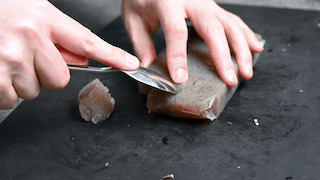
Leave a rating and a comment